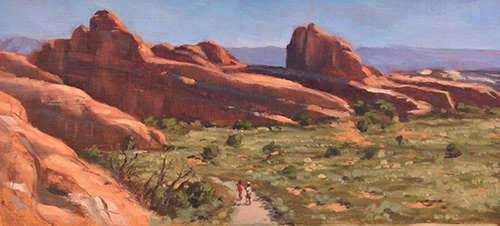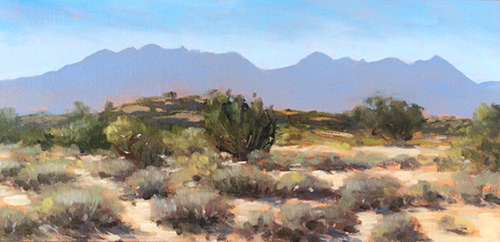– Bob Bahr reporting, Editor PleinAir Today –
The temperature often exceeds 100 degrees Fahrenheit during the summer in Arches National Park in Utah. But artists still flock there because of the beauty. Barrett McDevitt explains his coping strategy for hot times in Arches.
Lead Image: “Moab Study,” by Barrett McDevitt, oil, 5 1/2 x 14 in.

The artist recently painted in Arches in the August heat — actually, he painted and camped in the heat. “It was very hot, but the subject matter was amazing, and by using care, it is quite possible to work comfortably in these conditions,” says McDevitt. He outlined some of his tips for staying safe and comfortable in high temperatures.
- “Heatstroke is serious business; if you have any concerns about your health, seriously reconsider painting outdoors in elevated temperatures,” says McDevitt. “Also, certain medications may make the elderly vulnerable to dehydration and heatstroke.”
- “Get out early or paint late! It is best to arrive at your painting spot before sunrise and get set up and situated in the cool pre-dawn air. Then when the sun hits, you are able to devote your full attention to painting.”
- “Wear proper sunscreen, SPF-rated lip protection, and/or light clothing with full coverage.”
- “Obviously, obtain a great hat! Mine is an Adam’s Headwear Extreme Condition hat. It has a wide brim and protection for the back of my neck. I fancy I look like I’m in the French Foreign Legion; my friends say I look like an enormous nerd. So be it. My wife also bought me Miracool cooling bandanas. You soak them in a cooler for 15 minutes —they have gel beads inside that expand and absorb the moisture. Wear one around your neck and they keep you cool for a remarkably long time.”
- “If at all possible, find a shaded area from which to paint. Consider the path of the sun and determine whether your spot will remain in the shade for the duration of your painting.”
- “If a shaded spot is not an option, an umbrella is a must! Preferably a large umbrella. I like to carry all my gear in a backpack. This allows me to hike to viewpoints car painters can’t attain, but I always make sure to have my tripod-mounted umbrella along.”
- “Bring and drink at least two liters of water. It is a necessity to be well hydrated. I bring along a CamelBak and force myself to constantly drink. It is also a good idea to have had a proper meal and to have consumed plenty of water before arriving at your painting spot. In the high desert, even if it doesn’t feel like you are sweating that much, you are losing water. Always remember to drink.”
- “If at any time you feel dizzy, faint, or ‘off,’ just stop. We all know how engrossing a plein air painting can become. Time flies by, you forget your problems, deadlines, and just focus. I know of winter painters in Vermont who have ended up with frostbite because they were consumed with the work and forgot about the environment. If you are feeling at all faint, it is time to call it a day.”

Other sources back up McDevitt on these points. There are many guides online for staying safe in high temperatures, but here’s one succinct list. It’s for hikers, but applies well to plein air painters.





The other 3 seasons are even better and except for potential sun over exposure and windburn, are pretty comfortable and you might even have snow as an element to paint! I was in Arches the first week of March this year and it was perfect weather!